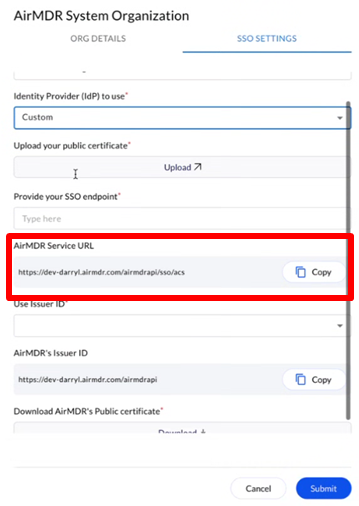Overview
SAML (Security Assertion Markup Language) integration with Azure AD enables Single Sign-On (SSO) functionality. This allows users to access multiple applications with just one set of credentials by securely transferring authentication and authorization information between Azure AD (the Identity Provider) and AirMDR (Service Providers).Pre-requisites
SSO Set-up & Configuration
1
Step 1
Configure Azure AD as the Identity Provider
- Sign in to Azure Portal with Azure AD administrator account.
- In the left-hand navigation pane, select “Microsoft Entra ID”.
- Click + Add dropdown list and then select “Enterprise application”.
- Choose the tab “Create your own application”.
- Provide a name for your application, in the “What’s the name of your app?” space.
- Select “Integrate any other application you don’t find in the gallery (Non-gallery)”.
-
Click “Create”.


2
Step 2
Configure Single Sign-On (SSO)
- Select “Single sign-on” from the left-hand menu on the application’s overview page.
- Choose the “SAML” option.
3
Step 3
Set Up Basic SAML Configuration
- Click the edit icon next to “Basic SAML Configuration”.
- Provide the required specifications as stated below
- Identifier (Entity ID): This is typically a URL specific to your application.
-
Reply URL (Assertion Consumer Service URL): The URL where Azure AD will send the SAML token.
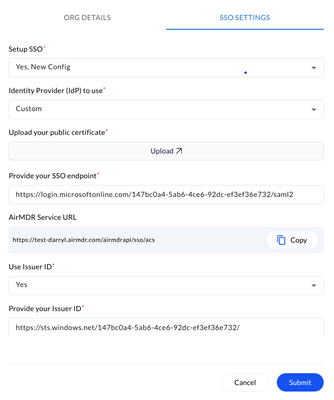
-
Click “Save” after entering the necessary information.
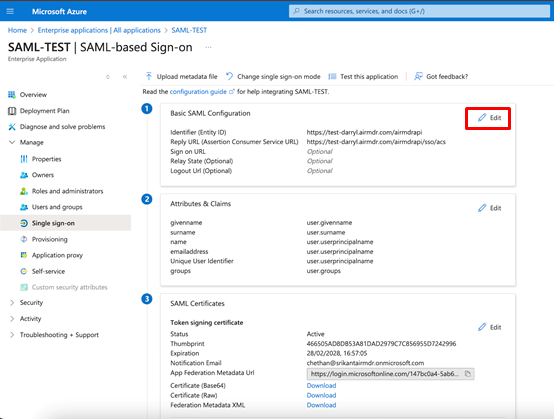
4
Step 4
Configure User Attributes and Claims
- In the “Attributes & Claims” section, click the edit icon.
- Ensure that the necessary user attributes (e.g., email, name) are correctly mapped to the corresponding claims required by your application.
- Remove the name space URIs for “givenname” and “surname” and update the keys to “firstname” and “lastname”.
-
Update the value for emailaddress to user.userprincipalname

5
Step 5
Download the SAML Signing Certificate
- In the “SAML Signing Certificate” section, download the “Certificate (Base64)” or Federation Metadata XML.
Certificate may be required by your application to verify the SAML token’s signature.
6
Step 6
Enable AirMDR access to Azure AD metadata
-
Copy the “Login URL and Microsoft Entra Identifier” from the “Set up [Your Application Name]” section.

7
Step 7
Set up and configure SSO in AirMDR UI
- Log in to the AirMDR.
-
On the bottom left, click on the User and select Go to Admin dashboard.
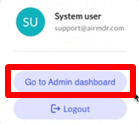
- Select the Organization for which SSO has to be set up.
-
Under the SSO SETTINGS tab, click Edit.
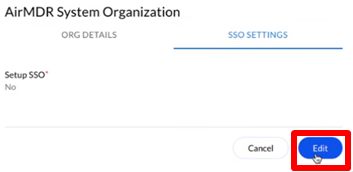
-
In the Setup SSO dropdown list, select Yes, New Config.
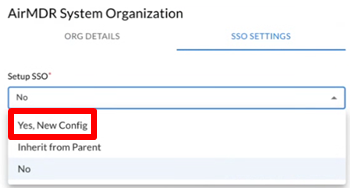
- In the SSO SETTINGS, provide the SAML Protocol Configuration Parameters from Azure AD
- In the Identity Provider (IdP) to use dropdown list select Custom
- Use Upload option to include the Identity Provider Certificate from Azure AD
- In the Provide your SSO endpoint, enter the Identity Provider Login URL from Azure AD
- In the Use Issuer ID dropdown, select Yes and provide Issuer ID from Azure AD
- In the Provide your Issuer ID, enter the Microsoft Entra Identifier
-
Click Submit. (SSO Authentication is successfully created for your account).

8
Step 8
Assign Users & Groups
- Select “Users and groups” from the left-hand menu, assign users/groups who will use SSO.
- Click “Add user/group”, select the users or groups you want to assign to the application, and click “Assign”.
Evaluate SSO Configuration
- Navigate to the AirMDR Login page.
- Enter the User Email ID assigned to the Azure SAML application, and click Proceed to Login.

- The page will be redirected to the Azure AD URL provided as the SSO Endpoint in the SSO SETTINGS.
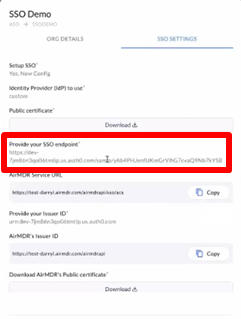
- Ensure that the test user can sign in successfully using Azure AD credentials.
- After successful login, the user should be redirected to Test case with a valid session
Hurray! You are Logged in Successfully


